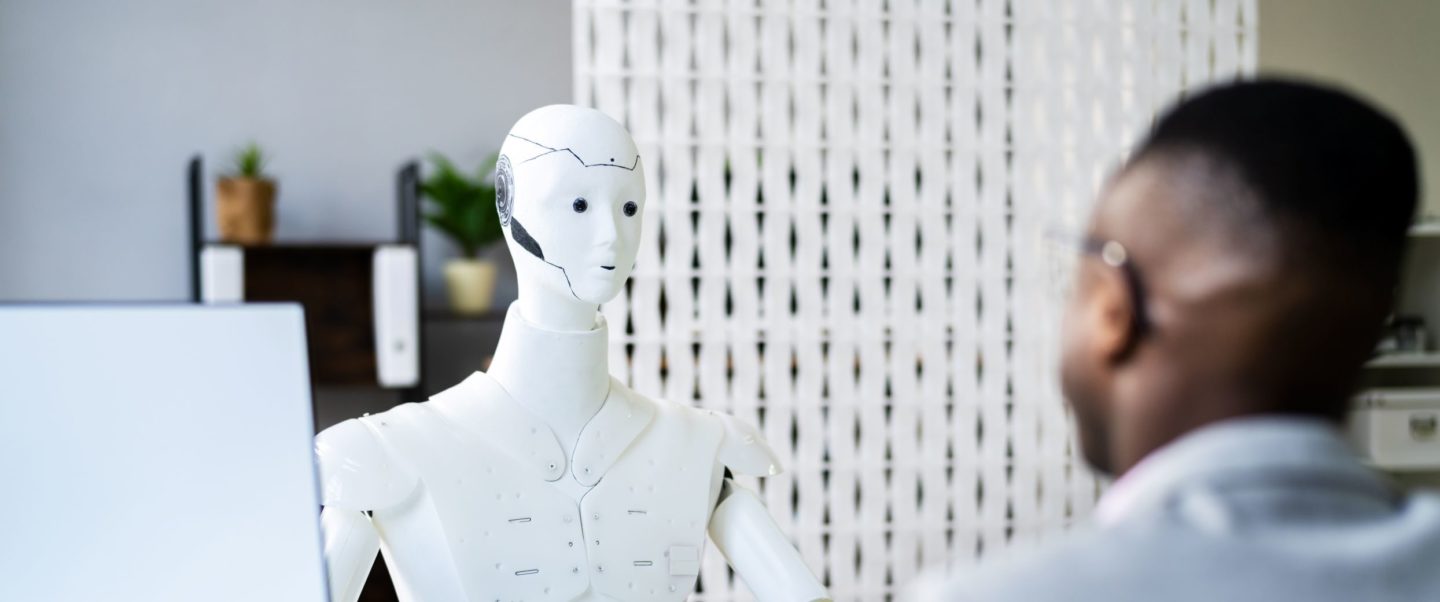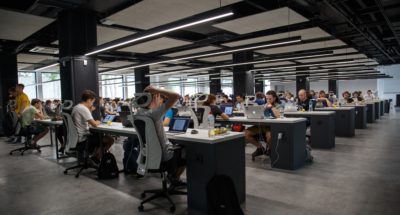
Reimagining the workplace
Intriguing innovation has opened up a “third space” to combine the advantages of the office and homeworking environments, suggest Johan Bjuregård and Peter Ingman, Co-Founders of Flowpass. ...

by Amit M. Joshi Published 12 June 2022 in Human Resources • 7 min read
Imagine you see a job advert for your dream role. Would you be happy for your application to be assessed by artificial intelligence (AI)?
For increasing numbers of job applicants, this is not just a hypothetical question. AI has rapidly become part of business, and HR has been one of the fastest adopters. It is changing recruitment permanently. Among the benefits are the potential to cut costs, identify more suitable candidates and minimize human biases and prejudices, which could transform businesses’ diversity efforts.
These are huge prizes. But success is not guaranteed: AI also has the potential to perpetuate familiar old biases and embed skewed recruitment decisions for another generation. So CHROs need to understand how they can mitigate AI’s diversity risks by developing a working knowledge of AI. They do not need to become AI experts or data scientists – but they do need to understand the basic principles of the technology and its implications for the business. Then, they can communicate with stakeholders both internal and external about how AI affects recruitment.

Recruiting is ripe for automation and AI because it involves large volumes of repetitive processes, such as screening resumés, and time-consuming but essentially straightforward tasks such as interview scheduling.
That is why the function has already adopted a range of tools spanning AI, machine learning and digital assistants. One 2019 study found that 99% of Fortune 500 companies were already using AI in the form of applicant tracking systems (ATS). Many of those who have changed jobs during the so-called Great Resignation will have encountered HR chatbots, which are based on conversational AI and carry out tasks such as candidate communications, sharing company policies and scheduling interviews.
Beyond that, AI and machine learning is used to screen candidates by evaluating their skills and experience against role requirements. A 2020 Mercer study found that 30% of businesses were using AI this way and 40% planned to start within 12 months. It seems likely that the pandemic has accelerated uptake.
Other uses include assessment of candidates’ performance on small quizzes or games, which can provide a measure of their aptitudes and reasoning capabilities – as adopted by FMCG giant Unilever, for example – or targeting recruitment advertising with potential candidates.
But AI has also been used in more controversial ways, such as to analyze facial expressions and tone of voice during interviews. Here, CHROs should proceed with caution. The underlying science is dubious: the connection between a candidate’s facial expressions and their technical skills relevant to a job – for example, what is required of a data analyst – is tenuous. The idea that such techniques can accurately predict complex human behaviors in the dynamic context of a real workplace is even less persuasive.
Worse still, analyses like this could be prone to bias on ethnicity and race grounds – by failing to ‘read’ minority groups properly. One leading provider of such technology announced in 2021 that it was dropping its product for facial analysis following legal challenges.
AI is a powerful tool for screening candidates, and reliable when it comes to the substantive content of what they say or write. But when they hear some of the claims made about AI, CHROs need to take care to distinguish between science and pseudoscience.
Most companies are reliant on third parties to provide the AI and machine learning tools that are becoming widespread in recruitment. Vendors may wish to protect their IP with secrecy, but the users should insist on clarity about how the system removes bias and ensures fairness. Providers also need to be clear about how feedback loops in the system enable the business to feed data, such as final recruitment decisions and outcomes, back into the tool so it keeps learning.
There are two valuable types of audit. The first is inside: auditing the data on hires made with AI input, including key dimensions of diversity, and tracking performance over time to evaluate whether hiring decisions work out. Then, consider the other side of the equation: are you rejecting the right candidates? To answer that, conduct outside audits. This could mean taking a sample of 50 failed candidates and reviewing their LinkedIn profiles to see what they have done since. Were you right to reject them? Or might you – or the AI – have made a mistake?
To further test the system, ask the AI to select a small number of candidates who failed its assessment and add them to the interview shortlist. They may well prove to be unsuited to the role – but confirming that is valuable, and worth the small additional time commitment. Throwing in some randomness helps to check the system is properly calibrated.
The benefits of using AI effectively can be significant. First, it can create significant speed and efficiency gains, reducing costs. Unilever, for instance has reported saving about 70,000 person-hours by using AI and technology. That can free up hiring managers to focus on the best-qualified candidates.
Second, it can help to find better hires. Faced with a large stack of CVs, a recruiting manager might start to skim read, missing key details. AI does not skim read, and used properly it can identify candidates who are the best fit for a given role. With the addition of feedback on the retention of those people and their advancement through the company, machine learning can refine its model over time. Many businesses are beginning to report improvements on metrics such as two-year retention from AI-enabled hires.
The way to maximize results is often to combine AI with human input. Research comparing the performance of AI and humans in finding errors in a piece of text has shown that AI now catches more errors than humans, and spots things that humans miss – but it has also found that humans catch errors that AI misses. The lesson is clear: it is a combination of artificial and human intelligence that will have the most powerful results.
The third advantage of AI in recruitment is its potential to remove bias by sweeping away the unconscious prejudices that can affect even the best-intentioned human recruiters.
However, exploiting this third advantage of AI is not straightforward. Concerns that AI could perpetuate or increase bias are common – held by 23% of HR professionals, according to a 2019 study by IBM. But CHROs need to grasp the distinction between two key concepts here: bias and fairness.
Bias is typically the result of AI being trained using skewed data, such as existing employees – the successful candidates of years past. That builds in a survivor bias, and teaches the AI to favor candidates who resemble the existing employee base. This was the problem at Amazon, which had to scrap a machine learning recruitment tool that was penalizing women. Part of the problem was that the model was trained using old resumés submitted to the company – resumés that were dominated by men.
Then there is the question of whether a tool is giving fair and ethical outcomes. Has the tool operated correctly in evaluating candidates? And are the resulting outcomes, at a systemic level, fair? Evaluating these may require leadership judgments – for instance about the organization’s desired representation of minorities.
AI can create significant speed and efficiency gains, reducing costs.
Some leaders have genuine questions about how much they should advertise their use of AI in recruitment. In general, for businesses today, the more transparency and openness the better.
That applies in recruitment, too. Secrecy about the tools used could be hugely damaging to trust in the brand if exposed. And while some applicants may be skeptical about AI, some research has suggested that the novelty of AI could instead encourage candidates to apply. Businesses should capitalize on that to encourage applications from diverse groups by talking about how AI could eliminate bias.
They can also demonstrate the benefits of AI in creating greater transparency about the results of applications: the results of AI assessment can be used to generate candidate feedback at a level that human HR teams cannot supply. Unilever, for instance, sends rejected candidates two pages of feedback, including suggestions on what they could do to improve their chances of success if they apply again. This shows that instead of creating a dehumanized application experience, technology can support a more engaged and personal experience.
So AI could improve recruitment by helping to create real diversity, but it could also entrench old biases. Ensuring it is a force for positive change has to be a priority for CHROs everywhere.

Professor of AI, Analytics and Marketing Strategy at IMD
Amit Joshi is Professor of AI, Analytics, and Marketing Strategy at IMD and Program Director of the Digital Strategy, Analytics & AI program, Generative AI for Business Sprint, and the Business Analytics for Leaders course. He specializes in helping organizations use artificial intelligence and develop their big data, analytics, and AI capabilities. An award-winning professor and researcher, he has extensive experience of AI and analytics-driven transformations in industries such as banking, fintech, retail, automotive, telecoms, and pharma.

11 September 2023 • by Johan Bjuregård, Peter Ingman in CEO Circle
Intriguing innovation has opened up a “third space” to combine the advantages of the office and homeworking environments, suggest Johan Bjuregård and Peter Ingman, Co-Founders of Flowpass. ...

17 February 2023 • by Susan Goldsworthy in CEO Circle
When senior employees at Dutch firm IG&H walked away in frustration with the company’s leadership, founder and CEO Jan van Hasenbroek realized that things had to change. Susan Goldsworthy, Affiliate Professor of Leadership,...

9 December 2022 • by Shlomo Ben-Hur, Steven Smith in CEO Circle
To retain the best and grow talent, organizations must recognize that learning and development is no longer a “nice to have”. ...

8 December 2022 • by Lars Häggström in CEO Circle
Much of the concern about workers disengaging from their jobs focuses on the younger generations. This misses an opportunity to consider how leaders can raise engagement across the workforce....
Explore first person business intelligence from top minds curated for a global executive audience